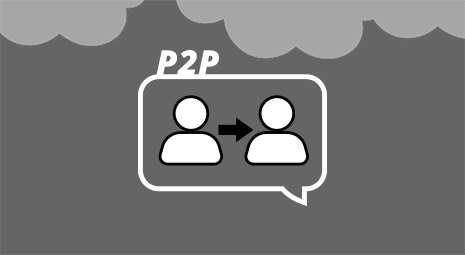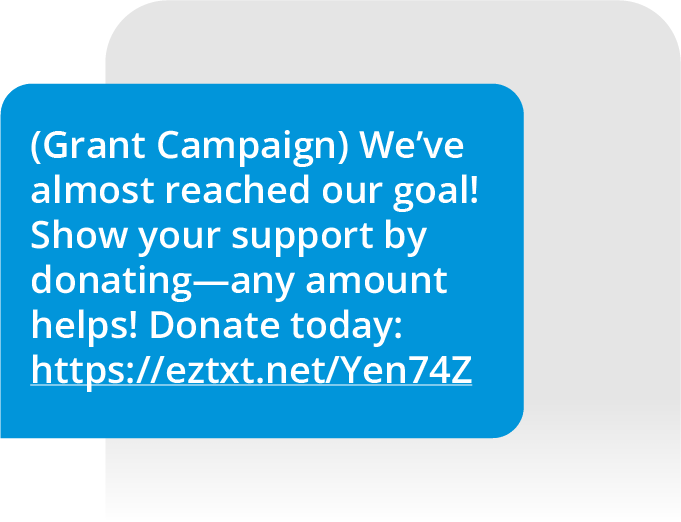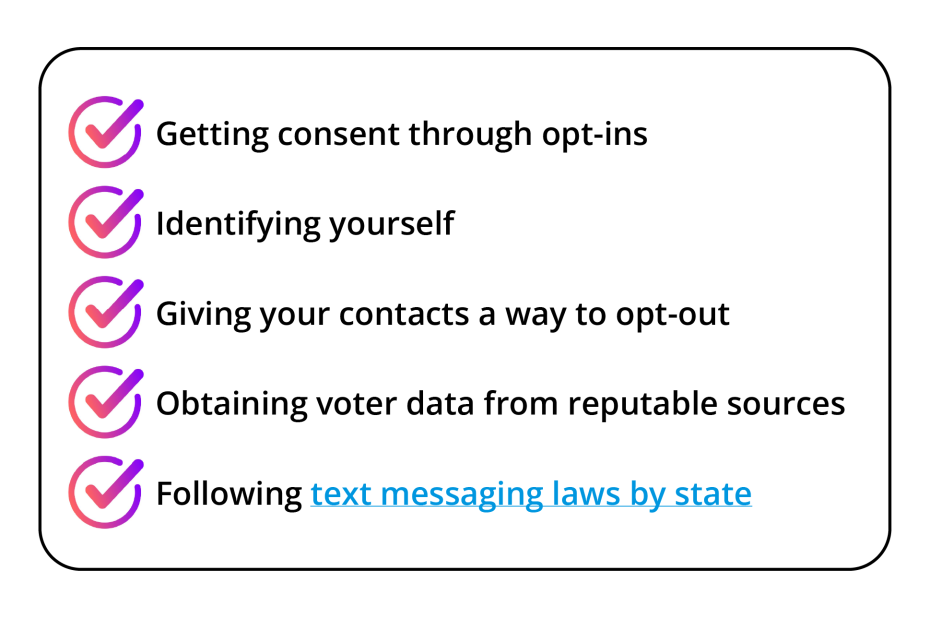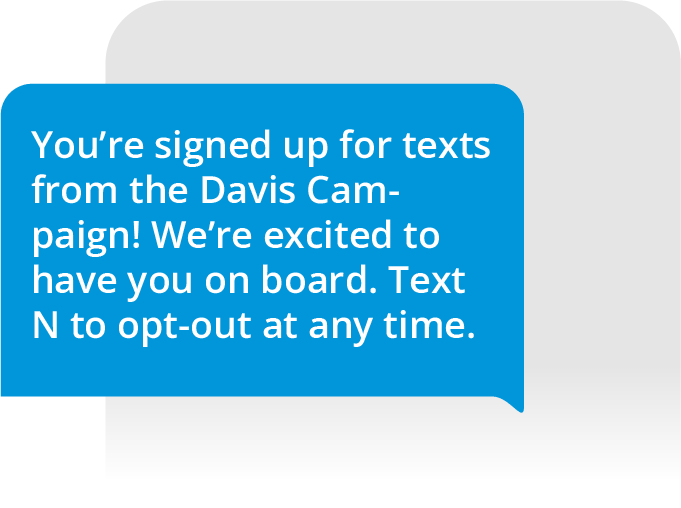A2P vs. P2P Text Messaging: Boost Your Political Campaign
Go deeper into A2P vs. P2P and learn how to reach large audiences while connecting individually with voters year-round.

There is much to know about political texting, from SMS best practices to compliance to simply how to reach voters.
One of the questions that campaigns and other political organizations ask is what the difference is between A2P vs. P2P.
A2P and P2P are two different texting communication methods with voters, but one’s more expensive and time-consuming (spoiler alert: P2P).
Today we’ll explore these two little acronyms that hold much weight in the political texting world and explain why choosing the right political outreach tool for your next campaign is so important.
WHY IT MATTERS
A2P platforms like EZ Texting serve as an express lane to obtaining Dedicated Short Codes (DSCs) and 10-digit Long Codes (10DLCs) that deliver multiple useful ways to intensify your campaign outreach.
We provide fast, easy, and compliant A2P (Application-to-Person) messaging you can effortlessly automate across your team instead of the manual, more expensive, and lower volume alternative of P2P messaging.
Automating more of your outreach through EZ Texting returns time to you for what’s more important – gathering, targeting, and reaching contacts all year!
A2P vs. P2P: What’s the Difference for My Campaign?


The difference for your campaign regarding A2P vs. P2P is that, for the context of this article, A2P is mass texting, and P2P is person-to-person texting.
A2P, shorthand for "Application to Person," denotes a messaging system where texts originate from a platform or automated service.
First introduced by Verizon in 2019, A2P SMS swiftly became the industry standard, ensuring the safety, security, and rapid delivery of text messages, a norm embraced by other carriers.
In this article, we refer to A2P texting as mass texting, where one message is sent to many (also known as “one to many”).
Effortless Political Texting Starts Here
Every contact counts! Gather, segment, and reach them all year.

P2P messaging, or “Peer-to-Peer" messaging, refers to direct communication between individuals, lacking the efficiency and reach of A2P messaging during an election cycle.
While P2P allows for personal interactions, it may not offer the scalability and speed required to disseminate crucial information to a broad audience swiftly and securely.
To outpace the competition and reach the furthest corners of your universe of contacts, your text marketing platform should employ mass texting features and one-to-one texting features.
Why Should My Political Campaign Use A2P?
Increased Trust
A2P messages come from verified phone numbers, which can help to increase trust with mobile phone subscribers.
Improved Deliverability
A2P messages are more likely to be delivered to mobile phone subscribers than messages sent from unregistered phone numbers.
Improved Customer Experience
A2P messages can help businesses and organizations to provide a better customer experience by allowing them to send timely and relevant text messages to their customers.
When you want to reach large groups of people quickly, A2P is your answer.
A2P allows your campaign to simultaneously send mass or group texts to your entire audience or certain segments through a DSC or 10DLC.
Your messages can be personalized and sent at scale to reach voters. Your mass texting can keep up as your list of text subscribers grows.
How to Use A2P in Your Political Campaign
As mentioned, A2P vs. P2P differs between group texting and two-way communication.
When using mass texting in your voter outreach strategy, you’ll incorporate A2P texting. Here are some of the best ways to use A2P texting in your political campaign:


Fundraising text messages are some of the best ways to use A2P mass texting in your political campaign — because the format of these messages can be applied broadly across contact segments.
Political fundraising messages can be generic (aside from using the contact’s first name).
Perhaps you’re a candidate who just announced your campaign and is sending fundraising messages to your contacts for the first time.
Or maybe you’re tying a fundraising push to a specific issue your audience is concerned about. Whatever the campaign milestone is, your fundraising messages can be crafted to reach a wide variety of people quickly and effectively using political text message service features, like automation, for follow-ups and reminders.
Simply create a message asking your audience to give financially to your campaign, click send, and watch the donations increase.

While many get-out-the-vote (GOTV) efforts can be tailored specifically to voters’ interests, concerns, and voting history, GOTV texts can also be sent to larger groups of people for general Election Day reminders and updates.
That’s the beauty of get-out-the-vote tactics: your campaign can directly target certain contact segments (like low-propensity or swing voters) to persuade them to vote while also sending “blanket” messages to your entire audience.
For example, at the beginning of an Election Year or midterms, you can use A2P messages to share information on voter registration and advertise voter guides.
Then, as voting day nears, election reminders and information can be sent to your subscriber list. Get more ideas on how to craft GOTV messages.

Campaign Updates
Campaign updates are another great use case for A2P texting because, like fundraising and some GOTV messages, campaign updates don’t necessarily require microtargeting for personalization or text replies for more information (another example of A2P vs. P2P).
Campaign updates could include sharing information about political rallies and candidate appearances, videos or links to blog posts of real stories, fundraising goals, and more that you can send to your whole audience or large contact groups.
A2P vs. P2P Compliance
If your campaign uses a texting platform for bulk texts and one-to-one conversations, the same compliance regulations apply to both methods.
But when a campaign leverages your volunteers’ personal networks for P2P texting, that lies outside of the rules of an organization texting a consumer (or a voter in this instance).
Therefore, when campaign volunteers text their family and friends — and only in this situation — your campaign doesn’t need to follow compliance rules because these P2P messages are purely personal.
However, it’s still a best practice to give your volunteer base some set messaging techniques and content guardrails, like avoiding offensive language, maintaining the campaign's voice, and other tips.
Now, back to discussing compliance for A2P and P2P texts sent over an application. The big question is, “How can I ensure my texts are compliant?” You can ensure your texts are compliant by:

Your text marketing platform should help you stay in compliance with regulations, like the Telephone Consumer Protection Act, as well as have built-in compliance features.

Additionally, you’ll need to verify your campaign through A2P registration. This type of registration is required by US mobile phone carriers to make sure that any texts sent from businesses and organizations to consumers are safe and legitimate.
Start Leveraging A2P Today
Now that you understand the differences between A2P and P2P, it’s time to implement them! There’s no better way to do that than with EZ Texting, your campaign’s all-in-one text marketing solution.
EZ Texting supports mass texting and two-way texting for political campaigns, has a built-in compliance feature called SafeSTOP, provides guided A2P registration, and even offers generative AI tools for crafting messages and managing replies — basically, all you need and more.
Give your campaign a boost by signing up with EZ Texting. Start effortless political texting today.
Happy texting!
Effortless Political Texting Starts Here
Every contact counts! Gather, segment, and reach them all year.
FAQs
Yes, text messaging can really win votes! Texting can cut through the noise of political campaign messaging from various channels by reaching voters directly and on a personal level. Political texting is immediate, convenient, engaging, and personal. Plus, with the help of SMS microtargeting strategies, political campaigns can connect with voters meaningfully, exactly where they are in their voting journey. This direct and engaging form of communication can not only persuade voters but also get them to the polls.
Yes, texting can help political campaigns outside of elections. Political texting can and should be utilized throughout the campaign cycle, from encouraging voter registration to expressing gratitude for support. Continuous messaging helps build relationships with voters, whether it’s an election year or not.
You can know if your texts are working to reach and mobilize voters by tracking key metrics, like click-through rates, event attendance, and fundraising goals. Additionally, you should be keeping tabs on when and how frequently contacts respond to questions or surveys, plus the nature of their responses (like if they’re planning on voting for you, a piece of legislation, and so forth).
But tracking metrics doesn’t do good if your campaign doesn’t change what’s not working. Incorporate A/B testing into your political texting campaigns to understand which formats, CTAs, and more resonate best with your audience. Use these insights to refine your strategy and boost engagement.
The political texting trends on the horizon include advancements in AI-powered personalization, like enhanced chatbots and virtual assistants, as well as robust voter data analysis for micro-targeting. RCS messaging will likely continue to evolve into a fantastic political messaging format to boost interactive engagement and provide a feature-rich experience for voters. To future-proof your campaign's text message strategy and stay ahead of the curve, keep tabs on technology, texting, and political communication trends.
See other resources related to:

